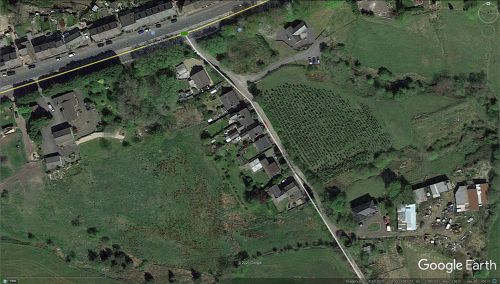Robin Hood figure (Mottram Moor)
From International Robin Hood Bibliography
| Locality | |
|---|---|
| Coordinate | 53.45897, -2.00017 |
| Adm. div. | Cheshire |
| Vicinity | At a well on or near Carrhouse Lane, on S side of A57 in Mottram Moor, near Mottram in Longdendale |
| Type | Artifact |
| Interest | Artifacts |
| Status | Extant |
| First Record | 1993 |
Robin Hood figure (Mottram Moor).
By {{subst:#realname:Henryfunk}}, {{subst:CURRENTYEAR}}-{{subst:CURRENTMONTH}}-{{subst:CURRENTDAY2}}. Revised by Henrik Thiil Nielsen, 2021-06-18.
A sculpture found at or near a well on or near Carrhouse Lane in Mottram Moor was believed locally to depict Robin Hood and was accordingly known under that name.
The artifact was described as follows in 1998:
[...] an attractive squatting full-size figure from Mottram Moor which may depict a native hunting deity. This figure is a half-life sized sculpture carved in one piece upon a low square plinth. Found near a spring, the figure once carried a bow which has since been lost, as at some stage the carving has been damaged [p. 229:] resulting in the loss of the left hand. [...] the circumstances of its original discovery remain unclear but in local tradition the figure was known as "Robin Hood" and a public house near the find-spot took its name from the local traditions surrounding the figure. [...] the "squatting" figure is [...] enigmatic in style due to the rarity of Celtic depiction of the full human figure. The face shows typical "Celtic" features in respect of the small lentoid eyes and individual curls of hair carved upon the head in Graceo-Roman style, and wears a short tunic which can be compared with figures known from Gaul, of second century AD date.[1]
The sculpture was acquired by Manchester Museum in 1974.[2] The local traditions were collected during interviews carried out in 1993 and 1996.[3]
Gazetteers
- Not included in Dobson, R. B., ed.; Taylor, J., ed. Rymes of Robyn Hood: an Introduction to the English Outlaw (London, 1976), pp. 293-311.
Sources
Maps
- 25" O.S. map Cheshire XI.3 (1886; surveyed 1872)
- 25" O.S. map Cheshire XI.3 (1898; rev. 1896) (georeferenced)
- 25" O.S. map Cheshire XI.3 (1898; rev. 1896)
- 25" O.S. map Cheshire XI.3 (1910; rev. 1907)
- 25" O.S. map Cheshire XI.3 (1938; rev. 1933–36)
- 6" O.S. map Cheshire XI (1882; surveyed 1872)
- 6" O.S. map Cheshire XI.NE (1899; rev. 1896–97) (georeferenced)
- 6" O.S. map Cheshire XI.NE (1899; rev. 1896–97)
- 6" O.S. map Cheshire XI.NE (1911; rev. 1907)
- 6" O.S. map Derbyshire II (1924; rev. 1919)
- 6" O.S. map Cheshire XI.NE (c. 1945; rev. 1938)
- 6" O.S. map Cheshire XI.NE (c. 1950; rev. 1938).
Also see
Notes
- ↑ Clarke, David. The Head Cult: Tradition and Folklore surrounding the Symbol of the Severed Human Head in the British Isles. Thesis submitted for the degree of Doctor of Philosophy. National Centre for English Cultural Tradition and Language, Division of Adult Continuing Education, University of Sheffield, 1998, pp. 228-29, 263 nn. 78, 79.
- ↑ Clarke, op. cit., p. 263 n. 78. Manchester Museum collection accession number, 1974.46.
- ↑ Clarke, op. cit., p. 263 n. 79.

